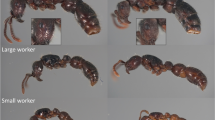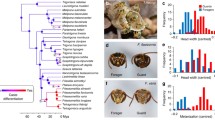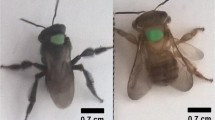Summary
The genusPlebeia has a special significance for the study of social evolution of stingless bees: morphologically primitive, its species display a wealth of behavioural evolution, especially with respect to the oviposition process. We comparePlebeia remota with the few other members of the genus studied so far.
Related to its subtropical geographical range, brood production is seasonal (there is no brood in the colony in colder months), and adult workers occur as summer and winter bees. The nest is in tree cavities, and the involucrum is absent or restricted to the winter period. Brood cells are arranged in horizontal combs, and new cells are built completely synchronously. Each series consists of up to 50 cells, their number being mainly dependent on colony size. Construction speed is remarkably constant, allowing 4–6 batches per 24 hours. Cell building and provisioning are activities of a small group of specialized workers.
The oviposition cycle follows the classical subdivisions for stingless bees. During the patrolling phase a worker may “offer” a trophic egg in a most remarkable way: while retreating backward from the queen she bends the abdomen under thorax and head, and lays an egg on the comb. This egg is eaten by the queen or a worker.
The provisioning, oviposition and operculation of all cells occur simultaneously, each cell is provisioned by 4–9 workers. Localization of a cell by the queen may be facilitated by its characteristic guard, which “defends” the cell against the approaching queen. The degree of synchronization within a batch is very high: the duration per cell lasts 420–950 sec, the batch of up till 50 cells needs only 557–1160 sec. Operculation is done by a worker that was not involved in the previous steps.
Males are generally produced by the queen. Several male producing cycles per year occur. In orphan colonies laying workers give rise to males, and in queenright colonies workers may occasionally reproduce as well.
Division of labour follows the general pattern for stingless bees; however, cell building and provisioning are activities of a specialized group of workers.
Similar content being viewed by others
References
Akahira, Y., S. F. Sakagami and R. Zucchi, 1970. Die Nähreier von den Arbeiterinnen einer stachellosen Biene,Trigona (Scaptotrigona)postica, die von der Königin kurz vor der eigenen Eiablage gefressen werden.Zool. Anz., Leipzig 185:85–93.
Bego, L. R., 1990. On social regulation inNannotrigona (Scaptotrigona)postica Latreille, with special reference to productivity of colonies (Hymenoptera, Apidae, Meliponinae).Revta. bras. Ent. 34:721–738.
Beig, D., 1972. The production of males in queenright colonies ofTrigona (Scaptotrigona)postica. J.Apic. Res. 11:33–39.
Camargo, J. M. E. 1989. Comentário sobre a sistematica de Meliponinae (Hymenoptera, Apidae).XVI Simpósio Anual da Academia de Ciências do Estado de Sõ Paulo.68 (Supl.): 41–61.
Camargo, J. M. F. and S. R. M. Pedro, 1992. Systematics, phylogeny and biogeography of Meliponinae (Hymenoptera, Apidae): a mini-review.Apidologie 23:509–522.
Camargo, J. M.F. and D. Wittmann, 1989. Nest architecture and distribution of the primitive stingless bee,Mourella caerulea (Hymenoptera, Apidae, Meliponinae): evidence for the origin ofPlebeia (s. lat.) on the Gondwana Continent.Stud. Neotrop. Fauna & Environ. 24:213–229.
Ceccato, S., 1970. Divisão de trabalho entre as operárias deMelipona rufiventris flavolineata Friese (Hymenoptera, Apoidea). São Paulo Dissertaçâo de Mestrado. Depto. de Zoologia, Instituto de Biociências, U.S.P., 30 p.
Cortopassi-Laurino, M., 1979. Observações sobre as atividades de machos dePlebeia droryana Friese (Apidae, Meliponinae).Rev. bras. Ent. 23:177–191.
Drumond, P. M., 1993.Estudos bionômicos em Plebeia poecilochroa (Moure & Camargo, in litt.) (Hymenoptera, Apidae, Meliponinae). MSc thesis Ribeirão Preto, Brazil.
Engels, W. and V. L. Imperatriz-Fonseca, 1990. Caste development, reproductive strategies and control of fertility in honeybees and stingless bees. In W. Engels, Ed., Social Insects: an evolutionary approach to castes and reproduction. Springer Verlag, 167–230.
Hebling, N. J., W. E. Kerr and F. S. Kerr, 1964. Divisão de trabalho entre as operárias deTrigona (Scaptotrigona)xanthotricha (Moure).Papeis avulsos Depto. Zool. Secr. Agr. 16:115–127.
Imperatriz-Fonseca, V. L. and M. A. C. Oliveira, 1974. Observations on a queenless colony ofPlebeia saiqui (Friese) (Hymenoptera, Apidae, Meliponinae).Bolm. Zool. Univ S. Paulo 1:299–312.
Imperatriz-Fonseca, V. L., M. A. C. Oliveira and E. S. Iwama, 1975. Notes sobre o comportamento dePlebeia (Plebeia) remota Holmberg (Apidae, Meliponinae).Ciência e Cultura, 27:665–669.
Imperatriz-Fonseca, V. L., A. Kleinert-Giovannini and J. T. Pires, 1985. Climate variations influence on flight activity ofPlebeia remota (Hymenoptera, Apidae, Meliponinae).Revta. bras. Ent. 29:427–434.
Kerr, W. E. and G. R. dos Santos Neto, 1956. Contribuição para o conhecimento da bionomia dos Meliponini. 5. Divisão de trabalho entre as operárias deMelipona quadrifasciata quadrifasciata Lep.Ins. Soc. 3:423–430.
Michener, C. D., 1990. Classification of the Apidae (Hymenoptera).Univ. Kansas Sci. Bull, 54:75–164.
Moure, J. S., 1961. A preliminary supraspecific classification of the Old World Meliponinae bees.Stud. Entomol. 4:181–242.
Ramalho, M., V. L. Imperatriz-Fonseca, A. Kleinert-Giovannini and M. Cortopassi-Laurino, 1985. Exploitation of floral resources byPlebeia remota Holmberg (Apidae, Meliponinae).Apidologie 16:307–330.
Roubik, D. W., 1983. Nest and colony characteristics of stingless bees from Panama (Hymenoptera, Apidae).J. Kansas Entomol. Soc. 56:327–355.
Sakagami, S. F., 1966. Techniques for the observation of behavior and social organization of stingless bees by using a special hive.Pap. Avulsos Zool., S. Paulo 19:151–162.
Sakagami, S. F., 1982. Stingless bees. In: Hermann, H. R. (ed.) Social Insects. New York,Academic Press, III:361–424.
Sakagami, S. F., D. Beig, R. Zucchi and Y. Akahira, 1963. Occurrence of ovary developed workers in queenright colonies of stingless bees.Rev. bras. Biol. 23:115–129.
Sakagami, S. F., C. Camillo and R. Zucchi, 1973. Oviposition behaviour of a brazilian stingless bee,Plebeia (Friesella)schrottkyii, with some remarks on the behavioural evolution in stingless bees. J. Fac. Sci. Hokkaido Univ., Ser. VI, Zool.19:163–189.
Sakagami, S. F. and R. Zucchi, 1974. Oviposition behaviour of two dwarf stingless bees,Hypotrigona (Leurotrigona)muelleri andHypotrigona (Trigonisca)duckei, with notes on the temporal articulation of oviposition process in stingless bees. J. Fac. Sci. Hokkaido Univ., Ser. VI,Zool, 19:361–421.
Sakagami, S. F., R. Zucchi and V. Portugal-Araujo, 1977. Oviposition behaviour inMeliponula bocandei, an aberrant african stingless bee, with notes on the mechanism and evolution of oviposition behaviour in stingless bees. J. Fac. Sci. Hokkaido Univ. Ser. VI,Zool. 20:647–690.
Sommeijer, M. J., 1984. Distribution of labour among workers ofMelipona favosa F: age polyethism and worker oviposition.Ins. Soc. 31:171–184.
Sommeijer, M. J., 1985. The social behaviour ofMelipona favosa F: some aspects of the activity of the queen in the nest.J. Kansas Entomol. Soc. 58:386–396.
Sommeijer, M. J., J. L. Houtekamer and W. Bos, 1984. Cell construction and egg laying inTrigona nigra var.paupera Provancher, with a note on the adaptative significance of the typical oviposition behaviour of stingless bees.Ins. Soc. 31:199–217.
Terada, Y., 1980. Estudos bionômicos em colonias dePlebeia (Plebeia)droryana Friese, 1900 (Hymenoptera, Meliponinae) na região de Ribeirão Preto, estado de São Paulo. PhD. thesis, Faculdade de Medicina de Ribeirão Preto, 185 p.
Terada, Y., C. Garófalo and S. F. Sakagami, 1975. Age survival curves for workers of two eusocial bees (Apismellifera andPlebeia droryana) in a subtropical climate, with notes on worker polyethism inP. droryana.J. Apic. Res. 14:161–170.
Wille, A., 1969. A new species of stingless beeTrigona (Plebeia) from Costa Rica, with descriptions of its general behaviour and cluster type nest.Rev. Biol. Trop. 15:299–313.
Winston, M. L. and C. D. Michener, 1977. Dual origin of highly social behaviour among bees.Proc. Natl. Acad. Sci. USA 74:1135–1137.
Wittmann, D., 1989. Nest architecture, nest site preferences and distributionof Plebeia wittmanni in Rio Grande do Sul, Brazil (Apidae: Meliponinae).Stud. Neotrop. Fauna & Environ. 24:17–23.
Zucchi, R., 1977. Aspectos etológico — evolutivos da bionomia do's Meliponinae (Hymenoptera, Apidae). Ribeirão Preto, USP, 204 p. Tese (Livre-docência). Depto. Biologia, Fac. Fil. Ciênc. e Letras.
Zucchi, R., 1993. Ritualized dominance, evolution of queen-worker interactions and related aspects in stingless bees (Hymenoptera: Apidae). In:Evolution of Insect Societies (T. Inoue & S. Yamane, Eds), pp 207–249.
Zucchi, R., 1994. A evolução do processo de tratamento das células de cria de Meliponinae: do antagonisme à dominância ritualizada (Hymenoptera, Apidae). In: R. Zucchi et al., Eds., Anais do 1. Encontro sobre Abelhas, p. 38–45, Legis Summa ltda, Ribeirão Preto.
Author information
Authors and Affiliations
Rights and permissions
About this article
Cite this article
van Benthem, F.D.J., Imperatriz-Fonseca, V.L. & Velthuis, H.H.W. Biology of the stingless beePlebeia remota (Holmberg): observations and evolutionary implications. Ins. Soc 42, 71–87 (1995). https://doi.org/10.1007/BF01245700
Received:
Revised:
Accepted:
Issue Date:
DOI: https://doi.org/10.1007/BF01245700




